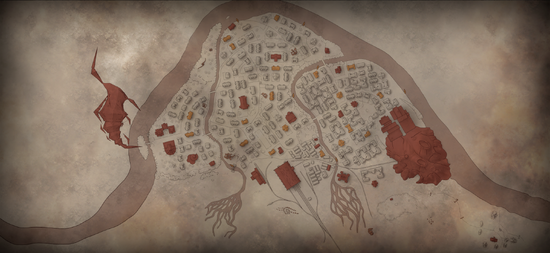
The Town as seen in Pathologic 2
| “ | This is a game about boundaries. Humans transcending their own limitations, and the metamorphoses that may await them on that journey: a blood cell or an udurgh, a doll or a living creature, a slave to the circumstances or the setter of new laws. Our town is a unique example of a utopia made real. It’s the cornerstone, the foundation of the game’s entire conflict: “a cataclysm has befallen the worthiest”. |
„ |
| — Pathologic 2 artbook |
The Town (Город) is a small, remote settlement, lost in the Eastern steppe. It developed from the Bull Enterprise—the town's meat-making industry, owned and operated by the Olgimskys. Unique and isolated, the Town combines various eras of history and all aspects of humanity. According to Vlad the Younger the town's population in Pathologic 2 is approximately seventeen-thousand people, thirty percent of which live in the Termitary and work for the Bull Enterprise. [1] The Town's population is comprised of both Townsfolk and Kinsfolk.
Due to its remote location the Town relies heavily upon supplies from outside sources in order to survive. In exchange for the meat produced by the Bull Enterprise the Town receives shipments of things that cannot be found in the Town such as sugar and medicine. These supplies arrive in the Town through the Train Station. A few months before the outbreak the shipment of supplies stopped, sending the Town into a deficit for a number of items. The relationship between the Town and the outside world is often compared to the relationship between a mother and a child, connected by an umbilical cord - the Station.
The Town is home to a number of remarkable people - such as the Stamatin brothers - because Simon Kain brought them into the Town. He wished to collect brilliant specimens and turned the Town into an Ark in doing so.
The Districts
The Town is divided into three areas by two tributaries of the Gorkhon river: The Guzzle and the Gullet. Each quarter has its own name and is divided into several districts.
Earth Quarter
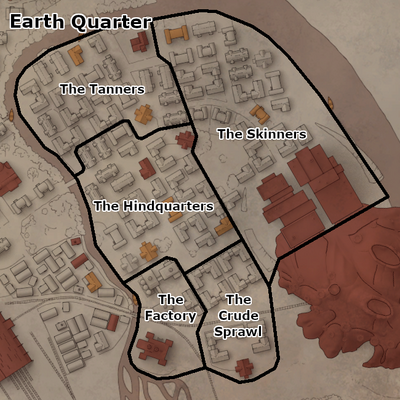
A map of Pathologic 2's Earth Quarter, with its districts bordered & labeled.
This is the eastern part of town, by the Guzzle.
- The Skinners (Кожевенный)
- Peter Stamatin's Loft
- The Termitary
- The Bone Stake Lot
- Sticky's House (Pathologic)
- Grocery
- Tailor
- The Hindquarters (Жильники)
- Stanislav Rubin's Apartment (Pathologic 2)
- Anna Angel's Willows
- Isidor Burakh's House
- Grocery
- Pharmacy
- Tailor
- The Factory (Заводы) ("Welcome to the machine")
Knots Quarter
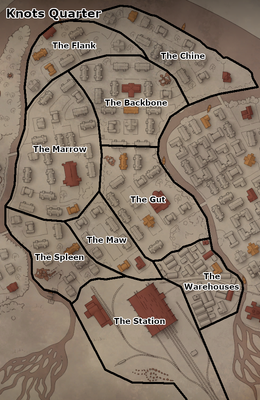
A map of Pathologic 2's Knots Quarter, with its districts bordered & labeled.
This is the middle part of town, between the Guzzle and the Gullet.
- The Flank (Седло)
- The Chine (Ребро)
- The Backbone (Хребтовка)
- The Marrow (Сердечник)
- Mark Immortell's Theatre
- Pharmacy
- Tadpole Yard Playground (Pathologic 2)
- The Gut (Утроба)
- The Olgimskys' Lump
- Pharmacy
- Tailor
- The Maw (Жерло)
- The Spleen (Почка)
- The Nutshell, the temporary residence of Khan (Pathologic 2)
- Stairway to Heaven
- Tailor
- The Warehouses (Склады) ("Only rats live here")
- Notkin's Soul-and-a-Half Fortress
- Bad Grief's Nest
- Stanislav Rubin's Hideout
- Grocery: Gnarl's Shady Shop, which offers services regardless of player reputation (Pathologic 2)
- The Station (Станция) ("Closed at the moment")
Stone Yard Quarter
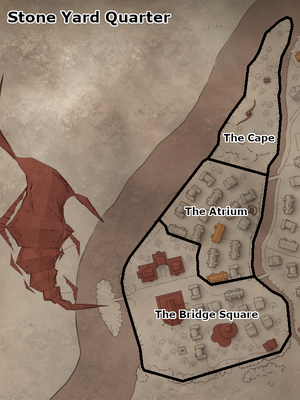
A map of Pathologic 2's Stone Yard Quarter, with its districts bordered & labeled.
This is the western part of town, by the Gullet.
- The Cape (Мыс) ("Dream Mistresses sleep here")
- Victoria's and Nina's Tombs
- The Atrium (Створки)
- The Bridge Square (Площадь Мост)
- The Polyhedron (Многогранник) ("The tower of children")
The Steppe
| “ | Has a thousand eyes | „ |
| — The Steppe's subtitle in Pathologic 2 |
The Steppe borders the town from the south, and is accessible from the Bridge Square, the Spleen, the Station, the Warehouses, the Factory, and the Crude Sprawl. There are two major marshes located in the Steppe, which connect to the Guzzle and Gullet tributaries.
The Steppe is plentiful with herbs. In Pathologic, all herbs can be found in the Steppe, and Worms will trade herbs to the Haruspex in exchange for healthy blood and organs, and food. In Pathologic 2, all common herbs and swevery grow in the Steppe, but ashen swish and white whip do not.
Marked Locations
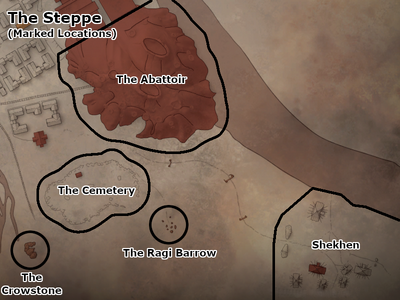
A map of marked locations in Pathologic 2's Steppe.
- The Abattoir
- The Ragi Barrow
- The Cemetery (Кладбище) ("You're always welcome here")
- Worm Yurts (Pathologic)
- Marked with the samn sigil south of the Atrium.
- Marked with an unknown sigil in the Guzzle's marsh.
- Marked with the soom sigil southwest of the Cemetery.
- The Crowstone (Pathologic 2)
- Shekhen (Pathologic 2) ("A place of old")
Traditions and Superstitions
- Few people fish in the River Gorkhon for fear of sharp objects like hooks.
- It is frowned upon to carry sharp objects such and knives and needles at all. Despite this, many still do.
- Digging well and holes (or otherwise piercing the Earth) is forbidden.
- Cutting bodies is taboo to everyone outside of a select few people called Menkhu.[2]
- Before the outbreak, townspeople engaged in a blind bartering game in which they exchanged unlabeled packages.[3][4]
- Locals refuse to drink water drawn from the River Gorkhon and instead prefer to drink stored water imported from rivers farther from the Gorkhon.[5]
Screenshots
An infected district under the blue light of the Plaguefinder
The Haruspex's Lair along the train tracks
A Tragedian in the rain
Townsfolk in the rain
The Haruspex's Lair from the Steppe
The Rod at night
The Chine, featuring a Stairway to Heaven
The Chine, featuring the Trammel
The Tanners, featuring the Rod
The Marrow, featuring the Theatre
Official Art
Concept Art
Paintings
Maps
Notes
- In the original translation, many areas had different names:
- The Guzzle was called the Vein.
- The Tanners was called the Fells, the Rod was called the Stem, and the Willows was called Verbae.
- The Skinners was called the Tanners and the Bone Stake Lot was called the Waste of the Bone Pillars.
- The Hindquarters was called the Veins.
- The Crude Sprawl was called the Damp District and the Termitary was called the Apiary.
- The Works was called the Factory and the locations there were called the Boiler, Braga's Lair, the Chopper, the Machinery, the Old Building, and the Warehouse, respectively.
- The Spleen was called the Kidney.
- The Marrow was called the Heart and the Spin-a-Yarn Square was called the Lace Square.
- The Chine was called the Rib and the Trammel was called the Seine.
- The Backbone was called the Spine.
- The Mouth was called the Cavity.
- The Flank was called the Loin.
- The Gut was called the Womb and the Lump was called the Clot.
- The Crucible in the Bridge Square was called the Horns.
- The Stillwater in the Atrium was called the Slough.
- The Atrium was called the Leaves.
- Some locations in town are in different districts depending on the game:
- Haruspex's Lair is located in The Works in Pathologic, but is in the Factory in Pathologic 2.
- The Broken Heart is located in The Tanners in Pathologic, but is in the Factory in Pathologic 2.
- Anna Angel's Willows is located inThe Tanners in Pathologic, but is in The Hindquarters in Pathologic 2.
- Isidor Burakh's House is located in The Skinners in Pathologic, but is in The Hindquarters in Pathologic 2.
- The House of the Living is located in The Gut in Pathologic, but is in The Flank in Pathologic 2.
- There is a location called The Works exclusive to Pathologic Classic HD. Here, there are The Boiler Room, Barley the Barber's Den, the Butchering Room, the Old Facility, and the Long Facility.
- There is also a location called The Mouth, which only has a park. These do not exist in Pathologic 2.
- There is a Stairway to Heaven located in The Chine in Pathologic Classic HD. The location of this Stairway to Heaven was changed to The Backbone for Pathologic 2.
- The Spin-a-Yarn Square, which exists outside of the Theatre, only exists in Pathologic Classic HD.
- The description for the Factory district references the song "Welcome to the Machine" by Pink Floyd. Interestingly, the lyrics refer to a son returning to a place called the Machine, which could be drawing a parallel to the Haruspex and his inheritance of the Lair.
- By walking alongside several warehouse buildings in the Warehouses in Pathologic 2, one is able to hear a recording of Ice-pick Lodge's lead Nikolay Dybowski doing a reading of Alexander Grin's "The Ratcatcher".[9]
- Interestingly, though commonly referred to as the "Town-on-Gorkhon", the Town is never referred to as such in any version of the games.
References
- ↑ "The strict blockade of the Termitary became a quarantine. Now we can be sure that thirty percent of the whole Town is quite safe. / A fresh census is long overdue, but as far as I know, the Termitary shelters about five thousand people."
- ↑ "Murder is a sin worse than digging wells in our town. Not because the soul is considered sacred, but because the body is. What is not whole, is not holy. A torn body is a foul mockery of the universe." - Pathologic 2
- ↑ "Barter has a long history in our community. It has many styles, such as "tit for tat." Sometimes, people even blindly swap wrapped items." - Pathologic 2
- ↑ "Long before the socioeconomic catastrophe, the local townsfolk developed a tradition of barter that the whole community reveled in. Including many types, such as "tit for tat" and "retrab", it is sometimes secret, with people swapping wrapped items blindly." - Pathologic: The Marble Nest
- ↑ "Water is brought to the town daily from a spring in the steppe and distributed among the households by water-bearers. The Gorkhon water was proven to be clean, but the locals refuse to drink it." - Pathologic 2
- ↑ PBSr Wendigo's Pathologic 2 Tinctures Guide
- ↑ HWynac's English map with names marked
- ↑ Za Warudo's "Quick and dirty Shop-type map
- ↑ - Pathologic 2 Warehouses Easter Egg (Youtube)
| |||||||||||||||||
 Welcome to the new Dark Mode! If you'd like to browse in Light Mode, head over to your
Welcome to the new Dark Mode! If you'd like to browse in Light Mode, head over to your 







































































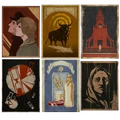


































![Map of various herb spawn points in Pathologic 2.[6]](https://static.wikia.nocookie.net/pathologic_gamepedia/images/1/1e/Pathologic_2_herb_locations.png/revision/latest/scale-to-width-down/120?cb=20200308223522)






![A labeled map of the Town as seen in Pathologic. Click to see full-sized image.[7]](https://static.wikia.nocookie.net/pathologic_gamepedia/images/1/1e/Detailed_gorkhon_map.jpg/revision/latest/scale-to-width-down/120?cb=20160812190058)

![A map of store types and locations in Pathologic. Click to see full-sized image.[8]](https://static.wikia.nocookie.net/pathologic_gamepedia/images/4/40/Pathologic_store_map.jpg/revision/latest/scale-to-width-down/120?cb=20161211232030)



